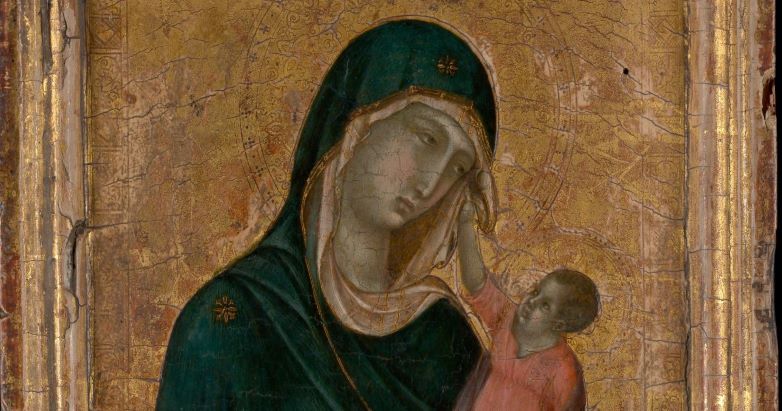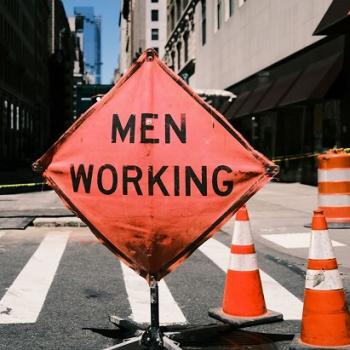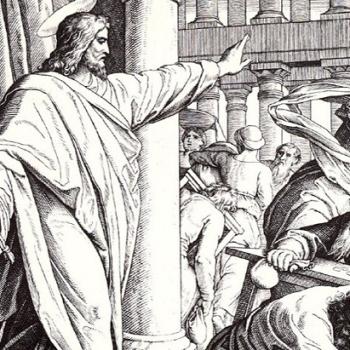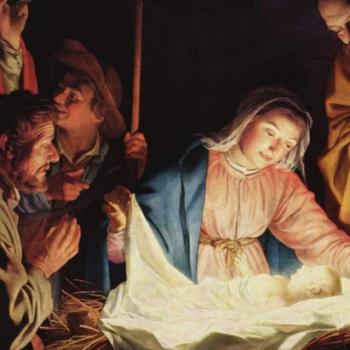
As we enter the Christmas season, I want to reflect on Jesus’ birth as the herald of a watershed reversal in history that brings gloriously good news to a wounded, broken world. His birth is the second Genesis, creation’s second chance, and the reversal of our grim fate that he accomplishes is reflected in other, smaller reversals, even a reversal of gender roles, which becomes evident in comparing Adam and Eve to Mary and Jesus. Without negating the customary Christian view that Adam:Jesus as Mary:Eve, these reversals enrich the conventional typologies and potentially challenge the idea of certain static, divinely-ordained gender roles. Moreover, as a man, Jesus continues to challenge traditional gender norms in his interactions with women.
In the Beginning x 2
In the beginning, God created a perfect world that human sin cast into darkness and death.
Then two thousand years ago, Jesus, the Word who created the world, entered the world as a baby to undo that darkness. John explains in the language of Genesis: “In the beginning was the Word, and the Word was with God, and the Word was God. He was with God in the beginning. Through Him all things were made, and without Him nothing was made that has been made. In Him was life, and that life was the light of all people. The light shines in the darkness, and the darkness has not overcome it.” (John 1-5)
From darkness to light, from death to life, from curse to blessing: Jesus undoes the Fall. But even more reversals are potentially at play here. In the first Genesis, woman (Eve) is taken out of man (Adam); in the second Genesis, man (Jesus) is taken out of woman (Mary). While some would argue that Eve wasn’t taken out of Adam, the manner of Jesus’s entry into this world isn’t the only potential way that he reverses Edenic gender roles. Whereas Eve, “taken out of” Adam, was the crown of creation and “mother all the living” (Gen. 3:20), that privilege is now claimed by Jesus. All Christians, whether male or female, are re-born from him. He is the Alpha and the Omega (Rev. 22:13), the firstborn of all creation (Col. 1:15), pre-existing with God, as well as the crown of creation: the pinnacle of human evolution.
Jesus, the New Eve? gender roles in genesis
In Romans 5:19, Paul alludes to Jesus as the typological Adam: “For just as through the disobedience of the one man the many were made sinners, so also through the obedience of the one man the many will be made righteous”. This is the usual way of thinking about Jesus, as the new Adam.
Yet in looking at the creation of Adam and Eve, Jesus, in his birth, most closely exemplifies Eve. In 1 Cor. 11:12, Paul also alludes to Adam and Eve in explaining how male/female roles reverse to emphasize gender mutuality under the preeminence of God*: “For as woman came from man, even so man also comes through woman; but all things are from God.” (1 Cor. 11:12)*
What is the theological significance of these gender role reversals?
The Nature of Wounding and Healing
When you have a wound, consider how it heals.
A couple of weeks ago, I accidentally cut myself with a paring knife while I was slicing an apple. The flash of pain as the blade cut into my skin was searing. It took about a week for what was rent apart to be reversed – undone – by the fusion of new skin cells growing together in the opposite direction of the wound. gender roles in genesis
Healing often entails rendering the opposite unto what has been harmed to restore it to its original state of wholeness. Light to beat back darkness. Blessing to beat back curse. Eternal life to beat back death.
Perhaps what these gender role reversals suggest is that gender role reciprocity, as described by Paul, is more the divine intention, rather than gender role division. Gender role reciprocity to beat back a gender hierarchy based on roles.
Of course some gender roles, such as childbearing, will always be dictated by our biological sex, but biological sex typically poses few absolute limits on the roles we can play. Childbearing and breastfeeding are exceptions to the rule.
Jesus: Challenging Gender Norms from Birth to Maturity
Complementarians would hold that certain church leadership (clergy) roles, as well as roles in the home, should be gender-based. Yet it is remarkable that in all the Gospel accounts of Jesus’ life, in all the interactions that he had with women, he arugably rebukes a woman only once – and he rebukes her for choosing to fulfill a traditional gender-based role in the home rather than engage in a traditional male activity! This is the story of Mary and Martha:
“As Jesus and his disciples were on their way, he came to a village where a woman named Martha opened her home to him. She had a sister called Mary, who sat at the Lord’s feet listening to what he said. But Martha was distracted by all the preparations that had to be made. She came to him and asked, “Lord, don’t you care that my sister has left me to do the work by myself? Tell her to help me!”
“Martha, Martha,” the Lord answered, “you are worried and upset about many things, but few things are needed—or indeed only one. Mary has chosen what is better, and it will not be taken away from her.” (Luke 10: 38-42)
Mary has chosen what is better. What Mary chose, listening at the feet of a rabbi, would have been considered very inappropriate for women at the time; in that culture, Martha is the one who should have been hailed as exemplifying a dutiful woman. But Jesus turns everything around. Mary took on a traditional man’s role, and Jesus not only affirms it as the “better” choice but proclaims that it will not be taken away from her.
This is a cautionary tale for anyone trying to limit women’s roles in the church.
Considering too Jesus’ interactions with the Samaritan woman at the well (John 4), the hemorraging woman who touches his robes (Mark 5:25-34), and others, a pattern emerges in which his outreach to women upends conventional gender norms. Jesus shouldn’t be interacting with these women, firstly because they are women, and “unclean” women at that. Oh, the scandal.
An obvious question arises here: if Jesus was such a gender-role bender, why did he not allow female apostles? Anglican theologian William Witt explains that Jesus chose only male apostles for the same reason that he chose only Jewish apostles. The purpose was typological: to show that these 12 Jewish men are the new Israel, representing the 12 tribes of Israel/twelve patriarchs from whom Israel is descended. Jesus recreates the Passover meal of bread and wine, symbolizing the new flesh-and-blood covenant with Israel, who is represented by 12 Jewish men.
Catholics have cited the male apostolate as a reason to exclude women clergy. Yet, in the same way that the apostles’ Jewishness shouldn’t exclude Gentiles from the priesthood, the apostles’ maleness shouldn’t exclude women from the priesthood either. Witt concludes: “There is no more theological warrant for contemporary clergy to be symbolically male than for them to be Jewish or to be twelve in number.”
Undoing the Distortion: Moving Toward the Kingdom of God
In the Fall, one of the principal areas of wounding was in gender relations, which become distorted by hierarchy (Gen. 3:16). Complementarians follow in the direction of this distortion when they inappropriately highlight Eve’s creation out of Adam as “evidence” that a hierarchy of gender roles always existed based on creation order. We need to consider the second Genesis account. The assertion of gender roles based on “who is taken out of whom” in Genesis is challenged, if not voided, by the Christmas story, where gender roles in Genesis dramatically reverse. Jesus whispers to us in his birth, and warns us in his maturity, that the kingdom of God does not necessarily reflect traditional gender norms and divisions.
*While 1 Cor. 11:1-16 contains statements that are foundational to complementarianism, scholars and theologians, such as William Witt, Philip Payne, etc., would argue that key words in these verses, “head” and “authority”, have been misunderstood. Moreover, as Witt notes in Icons of Christ, it seems likely based on grammar and narrative structure that the key phrase framing these verses, the lens through which they should be understood, is the verse I’ve highlighted, verse 11. This verse notably begins with “Nevertheless….”, and in it, Paul seems to caveat his discussion of particular circumstances at a church with a general, theologically based assertion of gender mutuality and interdependence. gender roles in genesis














